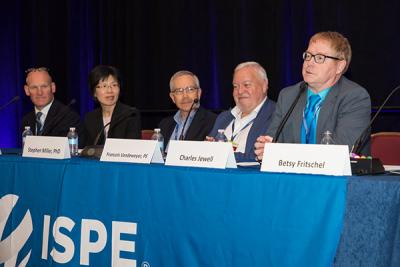Patient-Focused Harmonization Efforts - ISPE Quality Manufacturing Conference


“We serve patients.” This statement from the opening plenary address by Ronan Farrell, Global Head of Quality and Compliance, F. Hoffmann-La Roche AG, Basel, Switzerland, set the tone and the focus for the ISPE Quality Manufacturing Conference, held 4–6 June in Arlington, Virginia. As other speakers during the first conference sessions also noted, regulatory harmonization to enhance quality and get needed drugs to market is how the industry is trending to provide that service to patients.
“Patients are waiting.” This was Farrell’s second point to the approximately 250 attendees, emphasizing the critical nature of the pharmaceutical industry’s mission. Patients are waiting for supplies of both existing drugs as well as the delivery of new innovations, he said. Fulfilling the mission to deliver these presents both challenges and opportunities to the industry.
The Quality Manufacturing Conference was part of ISPE’s Quality Week, which included the ISPE Continuous Manufacturing Workshop on 6–7 June. About 25 regulators attended the Quality Manufacturing Conference from US FDA, UK MHRA, and Japan PMDA. Regulatory and quality topics were featured with the patient-centric focus as the theme.
Opening Plenary: Developing Areas
In his plenary presentation, Farrell highlighted several developing areas.
New modalities and technologies
Cancer care is becoming more personalized and is moving toward a one-patient, one-tumor profile, with an individual treatment plan for each patient. Farrell spoke about what his company is doing and about the challenges this revolution in treatment brings with it.

F. Hoffmann-La Roche has a personalized cancer vaccine program in clinical development to produce treatments via on-demand production. The therapy, which is potentially suitable for most tumor types, is custom made and individualized for each patient to induce a tumor-specific immune response. Phase 1 trials began last December.
Personalized treatment leads to manufacturing and quality challenges, he said. “We will need very adaptive quality systems, maybe new interpretations of cGMP, new approaches to change control, and process validation.” Will all regulators agree with cGMP, or will it vary around the world, he asked? Challenges from artificial intelligence and machine learning as data is processed to develop an individual solution for each patient and each tumor also need to be addressed.
Accelerated timelines
Speed to market is getting faster, Farrell noted, pointing out that FDA approvals now range anywhere from about 2.4 to 6.7 years; the average used to be 9 years, he said. Rapid clinical development is needed for faster time frames; expedited technical development is also necessary. Data analytics can replace clinical trials in some cases if they are well designed, Farrell said; this can be a development time saver. Post-approval changes will be needed to continuously improve processes, although securing these for products marketed in multiple countries is challenging to manage.
New skills and capabilities
Lifecycle management and regulatory convergence for accelerated filings and inspections are other components of accelerated development, but Farrell noted that a mindset shift is needed to be able to move forward with these initiatives.
A workforce that can serve these changing needs is also crucial. Internal development, collaboration with academia, partnerships, and mergers and acquisitions are some ways to build the needed skills and capabilities to serve the changing marketplace, he said.
“We all have a lot to learn on how to manage quality questions that come up from these modalities,” Farrell noted. When the industry turns to a one-batch, one-patient quality culture, the direct focus on the patient becomes very real. “It gives new meaning to ‘getting it right the first time.’”
Regulatory Focus
Other presentations during the first day’s plenary sessions focused on regulatory agencies and the work that is underway to expand harmonization around the world. .
ORA Update
An opening plenary presentation on US FDA Office of Regulatory Affairs (ORA) inspections by Alonza Cruse, Director, Office of Pharmaceutical Quality Operations, ORA/FDA, gave an overview of the work that ORA is doing in several inspection areas.
Overall ORA inspections through 31 May 2018 (not including bioresearch monitoring) have totaled 1,070. Of those, slightly more have been domestic (635) than foreign (436). Total inspections in recent years totaled 2,174 in FY 2017, 2,420 in FY 2016, and 2,161 in FY 2015.

The “Never-Inspected Firms” initiative, started in 2017, ties in with FDA’s aim to increase global oversight of all foreign drug firms, since never-inspected firms present a significant risk. The initiative’s three-year goal of inspecting all firms that have not yet received FDA inspections will likely be met during FY 2018. Between June 2016 and January 2018, these inspections have produced 38 warning letters and added 68 firms to the import alert list due to either GMP issues or refusal to allow the inspection. Cruse explained that this data can help feed the ORA’s risk model.
Top warning letter charges for OTC and other finished dosage form manufacturers from the never-inspected list include testing and approval or rejection of components, drug product containers and closures, and written procedures and deviations.
Cruse also provided a short update on the mutual recognition agreement (MRA) between the United States and the European Union, which came into effect in 2017 after nearly three years of FDA and EU cooperation as part of the Mutual Reliance Initiative. The MRA allows US and EU regulators to utilize each other’s GMP inspections of pharmaceutical manufacturing facilities. FDA and the EMA can now rely on information from drug inspections conducted within each other’s borders; this will avoid duplication of inspections, lower inspection costs, and allow regulators to devote more resources to other parts of the world where there may be greater risk. As of November 2017, the FDA had completed capability assessments of eight EU countries’ regulatory authorities. The goal is to complete all capability assessments by July 2019.
As of the Quality Manufacturing Conference, Cruse said that the FDA and EU have begun to exchange GMP documents; CDER reviews the site selection inspection list for facilities that require MRA review and works with partners to translate GMP documents; ORA and the Office of Pharmaceutical Quality Operations review and classify reports. FDA has now recognized 14 EU countries as capable of conducting human GMP surveillance inspections per US law: Austria, Croatia, France, Italy, Malta, Spain, Sweden, United Kingdom, Greece, Hungary, Czech Republic, Romania, Lithuania, and Ireland.
Finally, Cruse gave an overview of CDER’s Integration of FDA Facility Evaluation and Inspection Program for Human Drugs: A Concept of Operations (ConOps), which was introduced last year to improve oversight of increasingly complex global drug manufacturing. ConOps outlines workflow, roles, and responsibilities for ORA and CDER staff involved in pre- and post-approval, surveillance, and for-cause inspections at domestic and international drug facilities. It does not cover compounding, bioresearch monitoring, and pre-approval inspections for biotech products. The model establishes accountability for both ORA and CDER, creating clearer roles and responsibilities and better-defined time lines. It will inform additional operational plans scheduled to roll out in FY 2018.
MHRA and EMA
Mark Birse, Deputy Director, Inspection, Enforcement and Standards and Head of Inspectorate at MHRA, gave an overview of various regulatory harmonization initiatives from the MHRA and EMA points of view in “Global Regulatory Harmonisation.”
He briefly described the Joint Audit Programme and Joint Reassessment Programme, in which different agencies audit each other’s work on a five-year cycle. The initiative harmonizes with PIC/S and supports MRAs, including the United States and Canada. The goal is for participating nations to be able to rely on each other’s inspections performed in a third country.
Birse provided an overview and update of PIC/S, which leads international development, implementation, and maintenance of harmonized GMP standards and quality systems of inspectorates in medicinal products. There are only subtle differences between PIC/S and the US FDA, he noted.
Birse discussed the recently launched PIC/S Inspectorates Academy, a web-based educational center to harmonize and standardize international GMP training, and the Joint Visit Programme, which brings inspectors from different countries to watch inspections in other countries and then share what they have learned back home.

Birse also gave an overview and update on the International Coalition of Medicines Regulatory Authorities (ICMRA), a voluntary group of 23 member agencies and five associate members that works to leverage changes. The group does not itself implement any changes—the goal is to move regulation forward on a global basis. Projects undertaken since 2012 include a GMP project led by MHRA, supply chain track and trace, pharmacovigilance (big data, increasing adverse drug reaction reporting, vaccines post-immunization), innovation (global best practice for horizon scanning, leverage from outcomes—expertise and skills, novel licensing/early access scheme), and crisis management. An upcoming GMP project will address future assessment of risk.
FDA OPQ
Giuseppe Randazzo, Acting Director, Office of New Drug Products, CDER, FDA, updated attendees on Office of Pharmaceutical Quality (OPQ) initiatives and strategic priorities in “Global Quality—Promoting Better Medicines.” OPQ includes five elements: policy, assessment, inspection, surveillance, and research. These cross multiple programs, including new drugs, biologics, generics, biosimilars, OTC, and compounded drugs. OPQ’s work goes from development through post-market.
Quality metrics are important for reasons that go beyond FDA requirements that manufacturers have an ongoing program to maintain and evaluate product and process data related to product quality, Randazzo said. Quality metrics facilitate continual improvement and are mandated by ICH Q10. In addition, he cited research from St. Gallen University in Switzerland that indicates quality metrics programs are a good business practice. [1] Quality metrics also provide the FDA with quantitative and objective insight into the state of quality for both product and facility, enhance risk-based surveillance inspection scheduling models, and improve the effectiveness of inspections.
Randazzo shared OPQ’s strategic priorities through 2022:
-
Strengthen OPQ’s organization: Leverage a collaborative culture, an engaged and empowered workforce, streamlined processes, and effective teaming to ensure an efficient, high-performing, innovative, and results-oriented organization.
-
Promote availability of better medicines: Minimize barriers to encourage innovation within FDA and in the manufacturing sector through sensible oversight, research, risk-based decision-making, and continuous process improvement.
-
Elevate awareness of and commitment to the importance of pharmaceutical quality: Effectively communicate the importance of quality and that the American public can trust their drugs.
-
Strengthen partnerships and engage stakeholders: Build productive relationships with business partners within and outside FDA and jointly foster effective stakeholder engagement to meet the needs of the American public.
He outlined OPQ quality initiatives that are now underway.
-
The Emerging Technology Program supports development and implementation of innovative approaches in pharma design and manufacturing, identifies and resolves potential scientific and policy issues related to new approaches (for instance, enabled the approval of the first switch from batch to continuous manufacturing process for an approved drug). A web page, Emergening Technology Program ( [2] and Guidance for Industry document [3] were produced in 2017.
-
OPQ Science and Research includes manufacturing science and innovation, immunology, tumor biology, pharmaceutical analysis and characterization, and infectious disease and inflammation.
-
White paper published in January 2018 [4] describes key considerations when creating a QOS:
-
Explain product and process development in a patient-focused context
-
Effectively summarize the overall control strategy
-
Guide the regulator through the submission
-
-
Many generic applicants have effectively used a QOS based on a question-based review and may continue to do so in the future.
HeRandazzo also described the Integrated Quality Assessment integrated quality assessment (IQA), in which subject-matter experts conduct a quality assessment on an application, integrating assessments and inspections.
. IQAs are designed to benefit patients by creating better interactions between industry and the FDA. This is accomplished through a deep understanding of the products and processes, proactive communication, QOS, and other methods. The goal is a clear submissions with a rationale for the proposed control strategy, timely responses to FDA inquiries, and securing the supply chain.
Randazzo also reported on enhancements to modernize quality assessment and knowledge management throughout the drug product lifecycle:
-
A dashboard interface centered around quality risks for critical quality attributes, plus corresponding mitigation and control strategies for drug substance and drug product
-
A computer-aided interface for lifecycle knowledge management and standardization of ANDA quality assessment
-
A benefit-risk assessment framework that balances clinical context with potential product quality issues
Shared challenges for both regulators and industry include:
-
Facility quality issues that affect approvals of all application types; enhanced communications by both regulators and industry will help
-
Managing complex supply chain and manufacturing arrangements: multiple facilities and back-up facilities create the need for better quality agreements and enhanced communication for both contract manufacturers and API suppliers
-
Data reliability issues/concerns have significant impact on applications and FDA resources
Harmonization and quality
The final speaker in the first day’s plenary sessions, John Groskoph, Executive Director, Global CMC, Pfizer, Inc. focused on the importance of harmonizing approaches to quality around the globe with a discussion about the challenges to harmonization and how they affect the industry’s mission to serve patients.
 The first challenge is the difficulty of defining quality for a specific product, Groskoph noted. This presents many negatives for the industry, including increased manufacturing costs, barriers to continuous improvement, stifled innovation, overcomplicated supply chains, increased quality risks, and reduced quality assurance. The consequences for patients include delayed therapies, drug shortages, increased costs, and reduced trust in supply chains.
The first challenge is the difficulty of defining quality for a specific product, Groskoph noted. This presents many negatives for the industry, including increased manufacturing costs, barriers to continuous improvement, stifled innovation, overcomplicated supply chains, increased quality risks, and reduced quality assurance. The consequences for patients include delayed therapies, drug shortages, increased costs, and reduced trust in supply chains.
Additional challenges include multiple stakeholders with different objectives, multiple local/regional pharmacopeias, and increasing requirements for detailed cGMP information in regulatory applications. In addition, he said, post-approval implementation is complicated by extensive and uncertain regulatory review timelines. When under pressure to demonstrate that quality is assured for local populations, for example, regulatory authorities may deviate from global standards. Economic and political tension can result from the difference in quality expectations between local companies and multinational corporations. In some countries, ICH guidelines are only a minimum (i.e., some demand more stability data than ICH expects).
Groskoph cited the international initiatives working toward harmonization, many of which were discussed in greater detail by other speakers, including
-
ICH’s regulatory expectations/guidelines for harmonization
-
Mutual recognition agreements such as the recent MRA between the EU and the US (to be fully implemented in July 2019)
-
ASEAN 11-nation work-sharing program to develop a collective approach to assessing regulatory applications
-
PIC/S’s work to harmonize inspection criteria
-
Establishment of technical standards
Common themes among these initiatives and organizations:
-
Improve inspection criteria/focus to harmonize inspection reports and deficiencies descriptions and justifications
-
Improve convergence of pharmacopoeial monographs and procedures
-
Align harmonized application content, assessment timelines, and format
-
Align strategic interactions between industry and regulatory authorities—possibly joint interactions
-
Improve transparency and alignment for interactions among regulatory authorities
He concluded the morning’s presentations by noting that “We have come a long way, but we still have far to go.”
More Quality Week Coverage
Additional articles about the conference and the Continuous Manufacturing Workshop will be coming soon on iSpeak and in Pharmaceutical Engineering.
— Susan Sandler, Editorial Director
Disclaimer: This article contains brief, abridged, and informal synopses of remarks from UK MHRA and US FDA regulators during the ISPE Quality Manufacturing Conference proceedings in June 2018. This content has not been vetted by any agency and does not represent official guidance or policy of the MHRA or FDA.
References
- Friedl, Thomas, Prabir Basu, and Nuala Calnan. “FDA Quality Metrics Research: Final Report July 2017.” University of St. Gallen. http://tectem.ch/institute/opex/fda
- US Food and Drug Administration. “Emerging Technology Program.” https://www.fda.gov/AboutFDA/CentersOffices/OfficeofMedicalProductsandTobacco/CDER/ucm523228.htm
- US Food and Drug Administration. “Advancement of Emerging Technology Applications for Pharmaceutical Innovation and Modernization.” Guidance for Industry. September 2017. https://www.fda.gov/downloads/Drugs/GuidanceComplianceRegulatoryInformation/Guidances/UCM478821.pdf
- US Food and Drug Administration. “A Regulatory Perspective on the Quality Overall Summary: Putting the Pieces Together.” White Paper. January 2018. https://www.fda.gov/downloads/Drugs/DevelopmentApprovalProcess/Manufacturing/UCM593151.pdf



